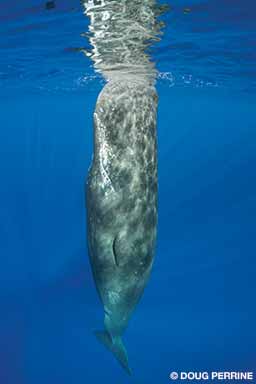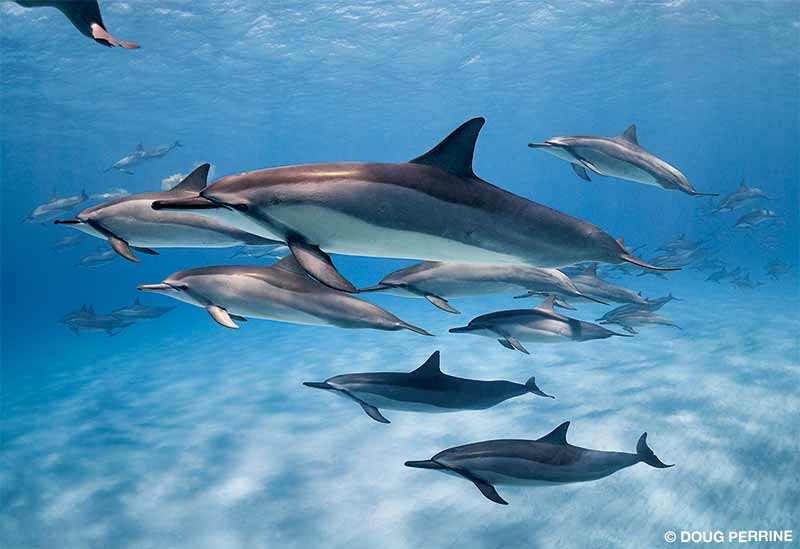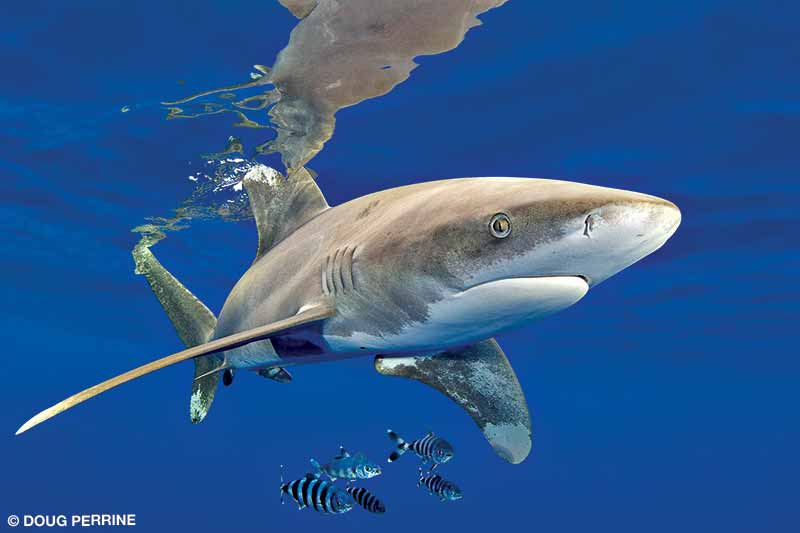Beberapa dekade yang lalu, saya meninggalkan Florida Selatan dan meninggalkan akses mudah ke terumbu dangkal yang indah di Karibia dan Bahama untuk pindah ke Hawaii. Salah satu daya tariknya adalah kedekatannya dengan air samudra yang dalam, jernih, dan biru yang dekat dengan pantai, sehingga memungkinkan akses untuk memotret beberapa hewan yang kurang dikenal yang mendiami zona ini.
Perairan sebening kristal dan kaya nutrisi mungkin ada di laut kutub dalam kegelapan musim dingin, tetapi di tempat lain, nutrisi di bawah sinar matahari menyehatkan fitoplankton, yang mengubah air menjadi hijau dengan klorofil. Fitoplankton memberi makan zooplankton, yang mentransfer energi matahari ke atas rantai makanan. Air yang jernih berarti miskin nutrisi. Karang dapat tumbuh subur di air jernih karena siklus nutrisi internal antara jaringan mereka sendiri dan ganggang fotosintesis simbiosis. Tetapi karang membutuhkan dasar yang keras dan air yang relatif dangkal untuk tumbuh.
Perairan lepas pantai yang dalam dan biru tidak memiliki terumbu karang dan hanya sedikit nutrisi, plankton, atau benda-benda yang dapat dimakan. Terlepas dari pertumbuhan ganggang yang sesekali muncul di perairan permukaan dan migrasi malam makhluk mesopelagis ke permukaan yang memicu kegemaran menyelam di perairan hitam, ini adalah gurun laut - hamparan lautan luas yang nyaris steril. Namun, di sinilah saya bertemu dengan beberapa makhluk terbesar di planet ini. Bagaimana perairan yang begitu steril bisa mendukung mereka?

Ketika kita menjumpai megafauna laut, kita hanya melihat sebagian kecil dari habitat dan kehidupan mereka, yang jarang sekali termasuk makan. Hewan-hewan ini dapat melakukan perjalanan ribuan kaki secara vertikal atau bermigrasi beberapa ribu mil secara horizontal untuk memenuhi kebutuhan nutrisi mereka. Beberapa di antaranya - paus sperma, misalnya - harus melakukan keduanya: turun ke kedalaman hingga satu mil atau lebih untuk menyantap kumpulan cumi-cumi dan menjelajahi petak-petak besar Pasifik untuk menghindari penipisan sumber daya makanan mereka di satu area.
Paus bungkuk memakan ikan-ikan kecil yang bergerombol dan krustasea di kolom air bagian atas. Aktivitas makan mereka biasanya terjadi di daerah yang air permukaannya dingin dan kaya nutrisi. Sebagian besar paus bungkuk yang menghabiskan musim dingin di Hawaii selama musim reproduksinya menghabiskan musim panasnya di Alaska. Paus sperma juga membutuhkan konsentrasi mangsa yang padat agar dapat makan secara efisien, tetapi umumnya mereka menemukannya dengan menyelam ke lapisan laut yang lebih dalam, tempat cumi-cumi berlimpah. Kita dapat melihat paus sperma di sekitar kepulauan ini setiap saat sepanjang tahun. Di musim dingin, Anda mungkin menemukan paus bungkuk dan paus sperma di sekitar Hawaii, tetapi hanya paus sperma yang sedang mencari makan, jadi mereka tidak bersaing.
Spesies megafauna lainnya berada di Hawaii sepanjang tahun. Mereka mungkin sesekali makan di dekat permukaan ketika air dingin membawa nutrisi, tetapi sebagian besar mendapatkan sebagian besar makanan mereka di kedalaman. Ketika saya pindah ke Hawaii, para ilmuwan hanya mengetahui sedikit tentang kebiasaan odontocetes (lumba-lumba dan paus bergigi) di sini, jadi saya tidak bisa menebak bagaimana lingkungan yang tampak monoton ini bisa mendukung keragaman tersebut. Namun, penelitian selama dua dekade oleh Cascadia Research Collective, yang dipimpin oleh Robin Baird, Ph.D., telah meningkatkan pemahaman kami. Memanfaatkan strategi yang dikenal sebagai niche partitioning, predator yang berbeda mengkhususkan diri dalam menangkap berbagai jenis mangsa atau mengeksploitasi sub-habitat yang berbeda, mengurangi tumpang tindih antara sumber makanan mereka. Peneliti lain telah mengungkap lebih banyak rahasia dari beberapa spesies.
Lumba-lumba spinner adalah ikon di Hawai, sering muncul di teluk pesisir dangkal di siang hari tetapi jarang mencari makan. Lumba-lumba spinner menggunakan habitat ini, yang terlindung dari serangan penyergapan vertikal yang mematikan oleh hiu, untuk beristirahat dan bersosialisasi. Pada sore hari, mereka menuju ke perairan yang lebih dalam, tempat mereka mencari makan terutama ikan lentera dan kadang-kadang cumi-cumi dan udang. Lanternfish berada di lapisan batas mesopelagis antara 1.300 dan 2.200 kaki, tetapi bermigrasi ke atas pada malam hari untuk menyentuh permukaan, di mana mereka dapat ditemukan oleh lumba-lumba dan penyelam air hitam. Penelitian yang dilakukan oleh Kelly Benoit-Bird, Ph.D., menetapkan bahwa lumba-lumba pemintal harus mengonsumsi rata-rata tiga hingga empat mangsa per menit selama 11 jam untuk memenuhi kebutuhan kalorinya. Lumba-lumba pemintal berpasangan untuk mengepung kawanan ikan lampion dan bergiliran mengambilnya dalam ritual pemberian makan yang terkoordinasi, yang menurut pencitraan sonar menyerupai tarian dansa.

Data dari tag satelit pemancar kedalaman Cascadia menunjukkan bahwa lumba-lumba bergigi kasar juga memakan ikan dan cumi-cumi di lapisan batas mesopelagis pada senja dan malam hari. Namun, mereka juga aktif mencari makan di siang hari, mengeksploitasi ikan-ikan kecil yang hidup di permukaan perairan samudra seperti ikan terbang dan ikan jarum. Lumba-lumba ini terkadang menangkap ikan sebesar dorado atau mahi-mahi. Pintar dan mudah beradaptasi, mereka telah belajar mencuri potongan ikan dari predator lain, termasuk paus pembunuh palsu dan nelayan manusia, dan telah belajar memanfaatkan jaring dan alat pengumpul ikan (rumpon) yang ditinggalkan. Meskipun biasanya berada di kedalaman 100 kaki di atas kolom air pada siang hari, mereka dapat melakukan penyelaman yang dalam untuk mencari makan.
Sebagai lumba-lumba yang panjangnya bisa mencapai hampir 20 kaki, paus pembunuh palsu juga memangsa ikan-ikan epipelagis (perairan permukaan laut). Meskipun mereka berbagi dengan lumba-lumba bergigi kasar beberapa mangsa seperti mahi-mahi, hanya ada sedikit tumpang tindih karena mereka dapat mengambil ikan yang jauh lebih besar, termasuk wahoo, ikan todak, dan tuna yang beratnya lebih dari 100 pon. Paus pembunuh palsu menggunakan strategi berburu yang unik. Kawanan paus ini terbagi dalam kelompok-kelompok kecil yang menyebar untuk mencari mangsa. Ketika seekor individu berhasil membunuh, ia akan mengumumkan hasil tangkapannya dengan suara berisik, dan anggota kawanan lainnya akan berkumpul untuk berbagi makanan. Paus pembunuh palsu di Hawaii terkadang akan melumpuhkan mangsanya dengan memukul ikan ke udara dengan capitnya.
Paus pilot bersirip pendek, yang sering disalahartikan sebagai paus pembunuh palsu, adalah jenis lain dari "blackfish" - enam spesies lumba-lumba yang biasa disebut paus. Paus pilot memiliki bentuk tubuh dan perilaku yang berbeda. Mereka umumnya bergerak lambat dan beristirahat saat berada di permukaan; makanan mereka sebagian besar terdiri dari cumi-cumi air dalam. Mereka menyelam di bawah 1.000 kaki untuk memakan cumi-cumi, gurita, dan ikan, tetapi penyelaman mereka semakin dangkal saat malam tiba dan mangsa mesopelagis lebih dekat ke permukaan.
Hiu sirip putih samudra terkadang mengikuti kawanan paus pilot. Kami tidak sepenuhnya memahami hubungan ini, tetapi hiu-hiu ini mungkin secara oportunis memanfaatkan mangsa paus dan telah difilmkan mengonsumsi muntahan dan kotoran paus. Hiu memiliki pola makan yang sangat luas, memanfaatkan nutrisi apa pun yang tersedia dan meminimalkan energi yang mereka keluarkan untuk berburu. Di Hawaii, mereka sering berada di dekat rumpon untuk memangsa ikan yang terluka, mengais umpan yang dibuang dan hasil tangkapan yang dilepaskan, serta memangsa ikan lain yang tertarik oleh rumpon. Mereka mendiami perairan permukaan laut terbuka hingga kedalaman 500 kaki atau lebih.

Hiu Galapagos juga memiliki makanan yang luas, tetapi berkeliaran lebih dekat ke pantai dan berburu di dekat terumbu karang dangkal dan dalam, serta di perairan permukaan. Perut hiu Galápagos yang ditangkap para peneliti di Hawaii berisi berbagai ikan bertulang, cephalopoda, hiu, pari, krustasea, dan mamalia.
Kami biasanya melihat hiu martil bergigi, seperti paus bungkuk, selama musim reproduksinya, saat mereka datang ke perairan dangkal untuk kawin dan memiliki anak. Di sepanjang Pantai Kona, kawanan hiu martil betina terkadang berkumpul di perairan dekat pantai di atas dasar yang datar dan berpasir pada kedalaman sekitar 200 kaki. Daerah ini tidak memiliki mangsa yang jelas. Studi penandaan menunjukkan bahwa ketika hiu martil pergi, mereka bergerak di atas jurang menuruni lereng terumbu dan mengikuti kontur curam ke atas atau ke bawah pantai, mungkin memakan ikan yang hidup di dasar laut dan invertebrata, seperti yang dilakukan spesies ini di bagian lain dunia. Hiu martil yang tertangkap di Hawaii memiliki paruh cumi-cumi pelagis di dalam perutnya, yang mengindikasikan kemampuan berburu di lepas pantai. Beberapa hiu martil dewasa ditemukan telah memakan anak-anak dari spesies mereka sendiri.
Pantai Kona juga terkenal dengan jumlah dan ukuran ikan marlin biru yang ditangkap di perairannya. Ikan ini lebih menyukai perairan permukaan lepas pantai yang hangat di atas termoklin, yang umumnya jernih dan tidak produktif. Penjelasan untuk kontradiksi yang tampak ini adalah pusaran siklon. Ketika arus kuat melewati ujung utara dan selatan Pulau Hawaii, arus tersebut dibiaskan ke dalam dan menyebarkan pusaran yang dapat berputar ke kedua arah. Pusaran siklonik atau berlawanan arah jarum jam, juga dikenal sebagai pusaran inti dingin, menarik air dingin dan sarat nutrisi di tengahnya, memicu ledakan kehidupan dan menarik tuna kecil dan ikan lain yang menjadi mangsa ikan marlin. Pusaran air searah jarum jam atau antisiklonik memiliki inti yang hangat di mana air permukaan terdorong ke bawah dan menciptakan kondisi penangkapan ikan yang buruk. Seperti banyak spesies megafauna laut lainnya, ikan marlin melintasi gurun biru lepas pantai untuk mencari oasis yang tersebar yang menyuburkan kehidupan.
Arus bawah yang dipaksa ke atas ketika menghantam punggung bukit dan puncak yang lebih dangkal di sekitar pulau-pulau juga dapat menghasilkan peningkatan nutrisi. Upwellings ini dapat menyebabkan lapisan permukaan linier yang menampilkan ganggang coklat panjang dan mikrofauna yang melimpah. Mengikuti luncuran ini kadang-kadang dapat menghasilkan pertemuan dengan megafauna seperti pari manta.
Dengan pemantauan lingkungan berbasis ruang angkasa dan teknologi yang lebih baik, fotografer sejarah alam di masa depan mungkin dapat menemukan kumpulan hewan laut liar dan menggunakan platform kamera yang dioperasikan dari jarak jauh untuk memfilmkan mereka di kedalaman, dengan kecepatan tinggi, dan tanpa mengganggu perilaku alami mereka. Untuk saat ini, saya terjebak dengan teknologi abad ke-20. Saya menghabiskan waktu berjam-jam yang panjang dan sebagian besar tanpa hasil untuk menjelajahi gurun bawah laut biru yang tampaknya tak berujung, berharap menemukan sesuatu yang menarik. Saya mengumpulkan foto-foto yang menyertai artikel ini selama seperempat abad dari pertemuan sesekali yang, meskipun jarang, membuat semuanya berharga.
Jelajahi Lebih Lanjut
Lihat lebih banyak lagi foto-foto megafauna karya Doug Perrine dalam galeri foto bonus ini.
https://dan.org/alert-diver/article/marine-megafauna-photo-gallery/embed/#?secret=oLm0UGWfaQ
© Penyelam Siaga - Q3/Q4 2021